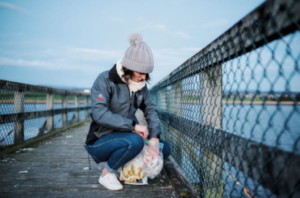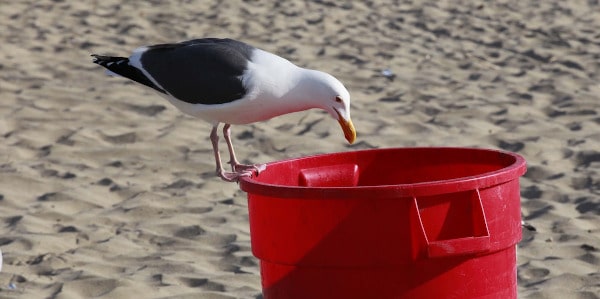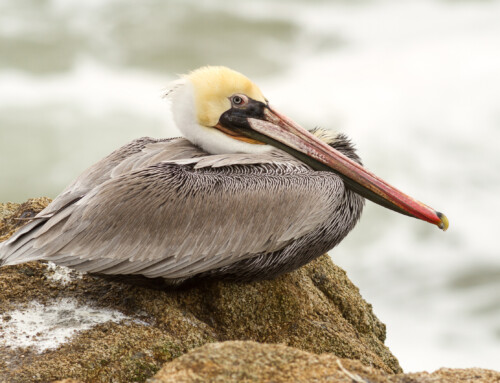LINKED PAPER
Seasonal ingestion of anthropogenic debris in an urban population of gulls. Stewart, L.G., Lavers, J.L, Grant, M.L., Puskic, P.S. & Bond, A.L. 2020. Marine Pollution Bulletin. DOI: 10.1016/j.marpolbul.2020. 111549. VIEW
They’re the “Jaws” of the skies with a hunger for hot chips. We’re talking about gulls. This family of seabirds (Laridae) are commonly found occupying coastal regions, however, in recent decades many species have shifted to overlap human activity and urban environments. Despite our perception that gulls are abundant, or even ‘pest’ species in some instances, numerous gull populations are in decline (Anderson et al., 2016; Coulson and Coulson, 1998; Robertson et al., 2001). The gulls’ unmatched ability to adapt their diet and foraging strategies has meant they can thrive in numerous environments. However, this may also be a reason for us to take a closer look at our feathered, inner-city residents.
Tasmania is the small island state located south of mainland Australia and is home to the Pacific Gull (Larus pacificus). In northern Tasmania, these majestic birds frequently roost in the picturesque, highly biodiverse Tamar Island Wetlands. This area is also referred to as kanamaluka, the indigenous name for the region. These wetlands are where something truly amazing happens. Roughly once a day, these birds produce what is known as a ‘bolus’. Essentially, gull vomit. This completely natural biological process not only allows the gulls to expel the items they cannot digest, but the boluses also provide scientists with extremely valuable data on gull foraging behaviour. Gulls are typically generalist scavengers consuming prey items that range from fish, molluscs and vegetation, to smaller seabirds and rodents (Buechley and Şekercioğlu, 2016): the signs of a hearty, natural meal. Unfortunately, however, we are increasingly finding boluses tainted with items that are far from natural. A sign that the anthropocene is well and truly in full swing.

Figure 1 The boardwalk at the kanamaluka/Tamar Island Wetlands where Pacific Gull boluses are deposited © Lillian Stewart
Recently, we completed a study of Pacific Gull boluses collected from the kanamaluka/Tamar Island Wetlands during 2018-2020. Boluses were sampled at monthly intervals to allow for comparisons to be made within and between the Austral seasons. The results were startling, especially considering the pristine nature of the kanamaluka/Tamar Island Wetlands and the remoteness and relatively small human population of Tasmania. Over 90% of the boluses we collected contained one or more items of anthropogenic debris (plastic, glass or metal), and 86.6% contained at least one item of plastic. Often, the boluses were a mixture of multiple debris types, with the standout items recovered being personal hygiene products, knife blades, dental floss picks, rusty nails, and a condom. All items indicative of household waste, and likely acquired by the gulls from a landfill.

Figure 2 Pacific Gull boluses collected in Tasmania during 2018-2020 (left panel) including a gull that had ingested a white plastic dental pick (top right panel) and a red plastic bread-bag clip (bottom right panel) © Lillian Stewart
The extent to which anthropogenic debris now dominates the diet of these birds is staggering. While the physiological impacts of debris ingestion in gulls is not known, there is a wealth of information available for other seabird species (e.g., Procellariformes) that suggests exposure to ingested debris items is problematic. For example, ingested plastic can introduce chemicals into an animal’s bloodstream, leading to reduced body condition and altered blood chemistry (Lavers et al. 2014, 2019).

Figure 3 Lead author of the 2020 paper in Marine Pollution Bulletin, Lillian Stewart, collects Pacific Gull boluses along the boardwalk © Jesse Benjamin
Another interesting point to mention is the path the anthropogenic debris takes, after being consumed and regurgitated by the gulls. Seabirds have previously been described in the scientific literature as “vectors”. This essentially means they can transport nutrients (e.g., in their guano) and other items to new locations. This process has also recently been used to describe seabirds ingesting plastics at sea and depositing these items on land (e.g., Buxton et al. 2013). However, less is known about the movement of debris items in the opposite direction, from land to sea. The high levels of debris we recorded in the Pacific Gull boluses, coupled with the deposition location (i.e., boardwalk through a freshwater ecosystem; see photo), means it’s inevitable that at least some of the anthropogenic items will find their way into the wetland through weathering and other processes. As all rivers lead to the ocean, including the kanamaluka/Tamar Island Wetlands and Tamar River, debris items ingested by the gulls at land-based landfill sites may unexpectedly enter the oceans. Sadly, the Pacific Gulls we studied are not unique in regard to this behaviour, with numerous gull species utilising landfills as a food source, worldwide. Fulmars (ocean-going seabirds famous for ingesting plastics) have been referred to as “Flying Trash Bins”, but it’s possible this name now applies to many of the world’s seabird species.
So what is our take home message? It’s surprisingly simple. The most common items we found in the gull boluses were single-use plastics; bread clips, bags, hygiene and dental products, food wrappers and cigarette filters. By refusing to use these items in the first place, we, the consumer, can prevent them from ending up in landfill, and therefore reduce the chance of consumption by gulls. Rebecca Prince-Ruiz, founder of Plastic Free July, sums it up perfectly: “These single-use plastic items found in the birds are ones we often use on a daily basis for just a few moments and can often find reusable alternatives for. It is after all our plastic, so the solutions need to start with us”. Plastic Free July may be over for this year, but our consumption of plastics continues. If many people make small changes, even something as small as using your own bag when shopping, then the collective effort of simple changes will spark the positive change needed to avoid our waste from entering the environment. After all, one man’s trash is another gull’s treasure.
References
Anderson, J.G., Shlepr, K.R., Bond, A.L. & Ronconi, R.A. 2016. Introduction: a historical perspective on trends in some gulls in eastern North America, with reference to other regions. Waterbirds 39: 1-9. VIEW
Buechley, E.R. & Şekercioğlu, C.H. 2016.The avian scavenger crisis: Looming extinctions, trophic cascades, and loss of critical ecosystem functions. Biological Conservation 198: 220-228. VIEW
Buxton, R.T., Currey, C.A., Lyver, P.O.B. & Jones, C.J. 2013. Incidence of plastic fragments among burrow-nesting seabird colonies on offshore islands in northern New Zealand. VIEW
Coulson, R. & Coulson, G. 1998. Population change among Pacific, kelp and silver gulls using natural and artificial feeding sites in south-eastern Tasmania. Wildlife Research 25: 183-198. VIEW
Lavers, J.L., Bond, A.L. & Hutton, I. 2014. Plastic ingestion by flesh-footed shearwaters (Puffins carneipes): Implications for fledgling body condition and the accumulation of plastic-derived chemicals. Environmental Pollution 187: 124-129.
Lavers, J.L., Hutton, I, & Bond, A.L. 2019. Clinical pathology of plastic ingestion in marine birds and relationships with blood chemistry. Environmental Science & Technology 53: 9224-9231. VIEW
Robertson, G.J., Fifield, D., Massaro, M. & Chardine, J.W. 2001. Changes in nesting-habitat use of large gulls breeding in Witless Bay, Newfoundland. Canadian Journal of Zoology 79:12, 2159-2167. VIEW
Stewart, L.G., Lavers, J.L., Grant, M.L., Puskic, P.S. & Bond, A.L. 2020. Seasonal ingestion of anthropogenic debris in an urban population of gulls. Marine Pollution Bulletin 160: 111549. VIEW
Image credit
Featured image: Gull looking into trash bin I kennedyfotos (pixabay.com)




